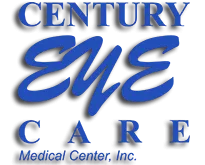Glaucoma is a group of eye conditions characterized by an increase in eye pressure. When the pressure in your eyes increases, it causes permanent damage to the optic nerve, causing a loss of peripheral vision. Although there is no cure for glaucoma, the professionals at Century Eye Care Medical can provide treatment options to slow the progression of the disease in hopes of preventing further vision loss.
Types of Glaucoma
There are two types of glaucoma. The first is open-angle glaucoma, which often shows no early symptoms. This type occurs when the fluid in your eyes drains slowly, similar to a slow drain. If the fluid cannot drain properly, the pressure in your eye can increase.
Angle-closure glaucoma is less common. It occurs when the fluid cannot drain from your eyes at all, causing a rapid spike in eye pressure. This rapid spike causes severe symptoms that can occur immediately.
Glaucoma Risk Factors
Anyone can develop glaucoma. However, certain risk factors can increase your risk of developing this disease, including:
- Family history of glaucoma
- Being over 60 years old
- Having heart disease, high blood pressure, diabetes, or sickle cell anemia
- Being extremely nearsighted or farsighted
- Previous eye surgery or injury
- Long-term use of corticosteroid medications, particularly eye drops
Glaucoma Symptoms
Open-angle glaucoma causes no early symptoms, which is why it is known as the silent thief of sight. As the condition progresses, you can experience patchy blind spots in your peripheral vision. In the advanced stages, tunnel vision is possible. Due to the rapid spike in eye pressure, angle-closure glaucoma causes more immediate, severe symptoms, including:
- Severe headaches
- Severe eye pain
- Blurry vision
- Redness of the eyes
- Seeing halos around lights
- Nausea
- Vomiting
Diagnosing Glaucoma
Our eye doctor can diagnose glaucoma during your annual eye exam. During a typical exam, our ophthalmologist will measure your eye pressure. If it is abnormally high, we will perform further tests to confirm the diagnosis.
- Pachymetry: This test is designed to measure the thickness of your cornea.
- Gonioscopy: This test allows your eye doctor to inspect your eye's drainage system.
- Visual field: This test is designed to test for peripheral vision loss.
Treating Glaucoma
Although there is no cure for glaucoma, there are treatment options that can slow the progression, preserving your vision longer. These include:
- Eye drops: In the early stages, your eye doctor can prescribe eye drops to reduce the pressure in your eyes.
- Laser trabeculoplasty: This laser eye surgery is designed to open the clogged channels in your eyes' drainage system.
- Filtering surgery: During this procedure, our ophthalmologist will create a small opening in the white of your eye to remove parts of the meshwork that prevents the fluid from draining.
- Drainage tubes: Tubes can be inserted into your eyes to drain the excess fluid.
Visit Our Ophthalmology Office in Hawthorne or Gardena for Glaucoma Treatment
Because glaucoma is so serious, annual visits to Century Eye Care Medical are essential. Our team is committed to providing patients at our Hawthorne and Gardena locations they need for optimal vision and eye health. Contact us today to schedule your first consultation. Learn more about how we can help you see clearly.

